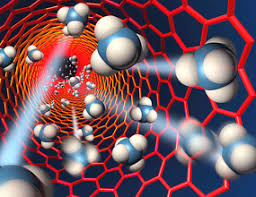Electronic storage capability (superconductivity) in carbon nanotubes and graphene particles (based on nano-microelectronics) (Educational-Research Ph.D.)
Researcher and author: PhD student Afshin Rashid
Note: In nanotubes, all three carbon atoms are capable of storing one lithium ion, whereas in graphite, all six carbon atoms are capable of storing one lithium ion. Also, the ability to store energy in nanotubes is multiplied by the volume of graphite electrodes.
Much hydrogen can be stored in nanotubes for energy and fuel cell applications. Have become superconducting. The radius of these superconducting nanotubes is only 6.4 nm. Phase transfer in one- or two-dimensional systems where the room temperature superconductivity can be found in carbon nanotubes and graphene particles and is based on room temperature conductivity. By passing liquid through the sheets of single-walled carbon nanotubes, electric voltage is generated. This technique is used to build liquid flow sensors to detect very small amounts of liquids and to generate voltage in biomedical applications . High-ionic liquids also generate more voltage .
The amount of heat gain and resistance of the nanotubes is proportional to the third root mass of the atoms and molecules. Heating also increases the strength of the nanotube and reduces its tensile strength by six times and increases its conductivity . As a result of the collision of atoms or molecules with carbon nanotubes, their electrical resistance changes.
Arc discharge method
In this method, the carbon atoms are heated and vaporized by passing high current through the two anode and cathode poles inside the helium gas plasma . The arc method is the most common, and perhaps the simplest, method for producing carbon nanotubes, in which a mixture of nanotubes and impurities is produced that separates the nanotubes from soot and metal . Talismans in the raw product are essential. In this method, the nanotubes are produced by evaporation of two carbon rods opposite each other, approximately 1 mm apart. The electrodes are housed in a chamber filled with an inert gas (helium or argon) at a relatively low pressure of 766-56 millibars. Generating a potential of about 26 volts with a current in the range of 166-56 amps causes electric discharge in the gas at high temperature and the heat caused by the discharge, one It evaporates from the carbon electrodes and forms a precipitate in the form of small rods on the other electrode.
Conclusion:
The electronic storage (superconductivity) in carbon nanotubes and particles of graphene nano-tubes are the ideal choice for many applications, has made a series of special coordinate carbon nanotubes, which are used in Tool making is centralized, making it possible to manufacture highly industrial tools.
Author: Engineer Afshin Rashid




